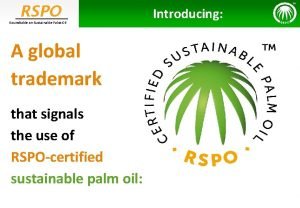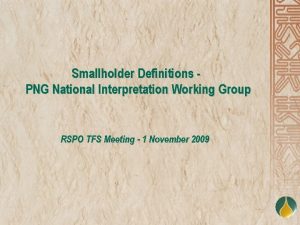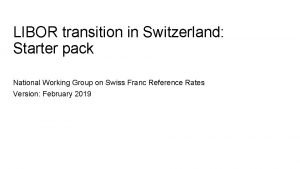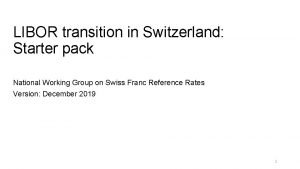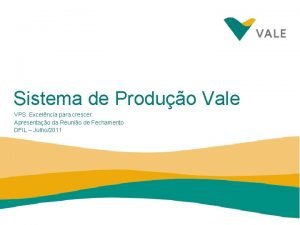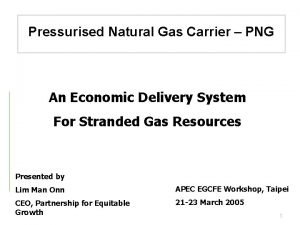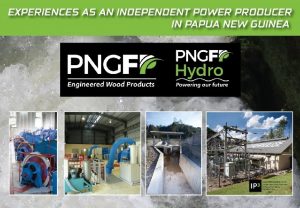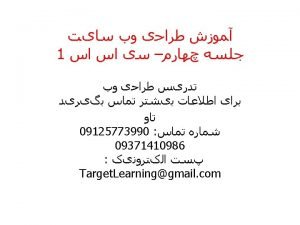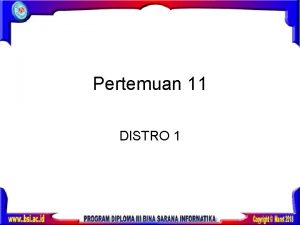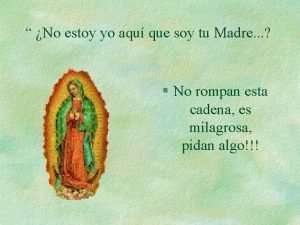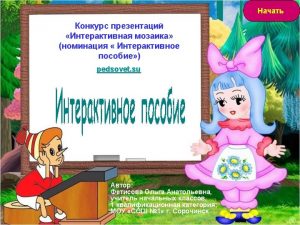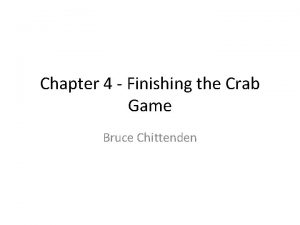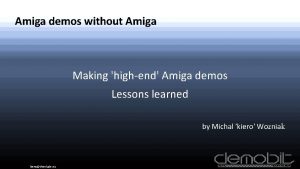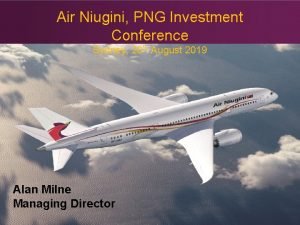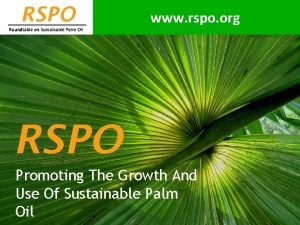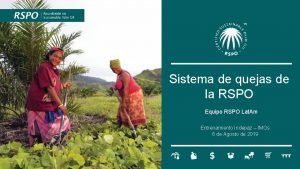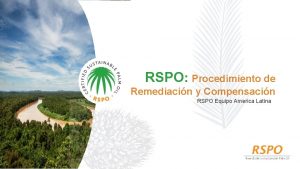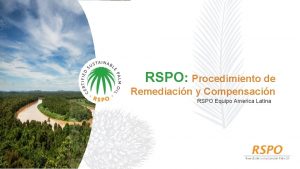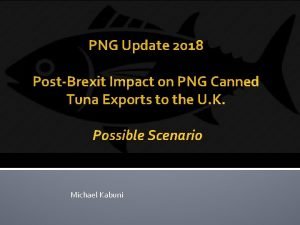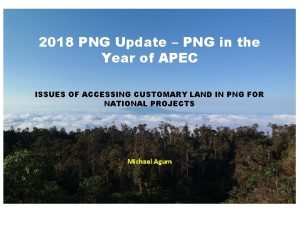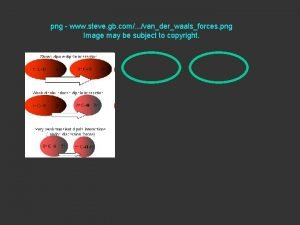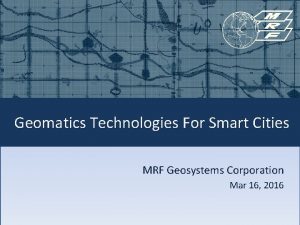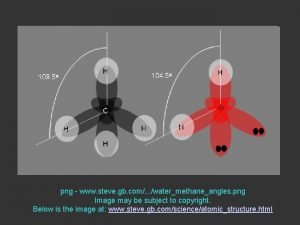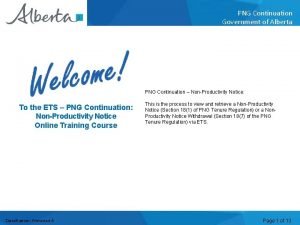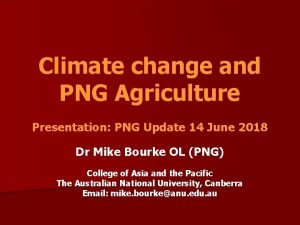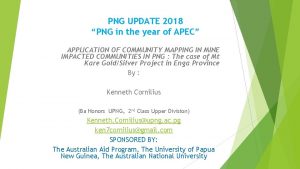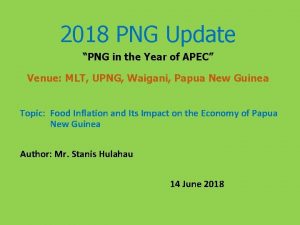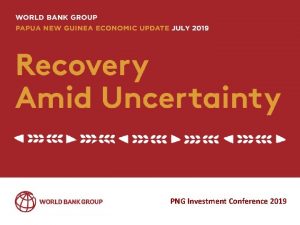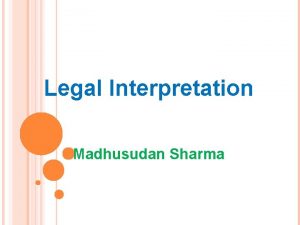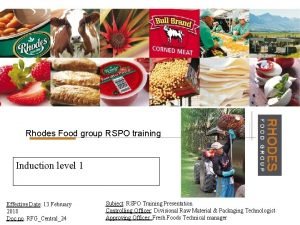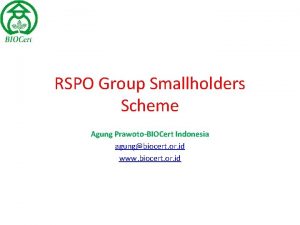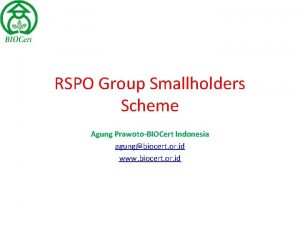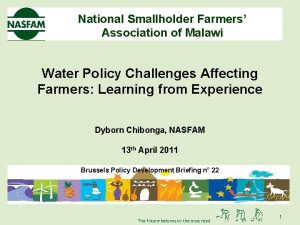Smallholder Definitions PNG National Interpretation Working Group RSPO



























- Slides: 27

Smallholder Definitions PNG National Interpretation Working Group RSPO TFS Meeting - 1 November 2009

Presentation: • Oil palm smallholders in Papua New Guinea • Smallholder classification and how this fits with the PNG reality • PNG NIWG definition and draft guidance for a 3 rd category of smallholder

Introduction: • RSPO has adopted a binary classification system for smallholders; ‘scheme’ & ‘independent’ smallholders • PNG doesn’t fit adequately within this classification system • PNG is using the ‘independent’ smallholder definition as this best describes the smallholders themselves, however higher standards of compliance are achievable • The PNG NIWG agreed that the development of a third category of smallholder was necessary and has prepared a definition and draft guidance for ‘Associated’ smallholders

Oil Palm in PNG: Factors that affect growth : Vanimo Kavieng 1987 New Ireland Rainfall 1800 - 5000 mm / year VOP Sunshine min of 2000 h / year Wewak Rabaul 1967 Hoskins between 22 – 32 o C VOP LSS 1969 Altitude less than 500 m VOP above SL Bialla VOP Temperature Kimbe Mt. Hagen Gusap 2005 Ramu Lae 1976 Popondetta LSS VOP Popondetta Daru Port Moresby VOP Alotau 1985 Milne Bay

Types of smallholder: Land Settlement Scheme (LSS) • ~ third of all current smallholdings; alienated land; 99 -yr Government lease; settlers from areas of high popn with poor development potential; now 3 rd/4 th generation; inward economic migration; population & land pressures; no more LSS Village Oil Palm (VOP) • Villagers growing oil palm on their own customary land; low productivity; Customary Rights Purchase Blocks (CRPB) • Purchase of usage rights, not title; Customary Land Usage Agreement; more significant in areas of high population pressure

Smallholders receive support from: • A national statutory organisation (OPIC) that provides extensions services to smallholders • A national R&D service provider, PNGOPRA, which is an NGO that works for both smallholders and plantations; and • Milling companies that provide, variously, FFB transport, extension support and credit for tools & fertiliser

FFB production and planted area in PNG:

Smallholder oil palm blocks in PNG: Number of smallholder blocks (Dec '08) Project Area # blocks Hoskins 7, 181 Bialla 3, 649 Popondetta 5, 707 Milne Bay 773 New Ireland 1, 282 Ramu 110 Total 18, 702

Smallholder related issues in PNG: • Low smallholder productivity • High population, esp. in areas with LSS • Limited land access for development • Poor (or non-existent) government support services esp. social and physical infrastructure


UN 50% Human Development Index for oil palm producing countries %of global CPO production 2008 45% 94. 9% of global CPO 40% SE Asia Central & South America 35% 30% 25% Papua New Guinea African Countries India 20% 15% 10% 5. 1% of global CPO 5% 0% 0. 30 0. 40 0. 50 0. 60 UN HDI 0. 70 0. 80 0. 90

Smallholder Definitions: Independent smallholders: • freedom to choose how to use their lands, which crops to plant and how to manage them • being self-organised, self-managed and selffinanced • not being contractually bound to any particular mill or any particular association • They may, however, receive support or extension services from government agencies

Smallholder Definitions: Scheme smallholders: • Structurally bound by contract, by a credit agreement or by planning to a particular mill • Often not free to choose which crop they develop • Supervised in their planting and crop management techniques • Often organised, supervised or directly managed by the managers of the mill, estate or scheme to which they are structurally linked

Smallholder Definitions: Certification: · Scheme smallholders should be certified along with the mill with which they are associated · Independent smallholders , who may sell their fresh fruit bunches either directly or through intermediaries to a number of mills, are to be certified on their own through a Group Certification Protocol

Smallholder characteristics: • Is the smallholder's FFB certified (as opposed to CPO at the mill)? • Are the smallholders themselves certified? • Do smallholders pay for certification themselves? • Does the mill collect & transport the smallholder's FFB? • Does the mill represent the only available market place for smallholder's FFB? • Do the smallholders have a contractual obligation regarding FFB supply to the mill? • Does the mill have a legal or contractual right to enforce (or demand) smallholder compliance? • Do the smallholders legally own or have legally protected customary usage rights to the land (independent of any involvement by the mill)?

Smallholder characteristics (cont. ): • Does the mill fully acknowledge the customary rights of smallholder landowners? • Are the smallholders fundamentally ‘Independent’ in terms of their rights of choice? • Does the mill, either through Government or some other parallel process, make provision for full and complete technical support to smallholders? And… • …is this technical support limited to influencing (as opposed to enforcing) compliance through education and awareness? • Is a project manager responsible for compliance? • Are the credit systems available to smallholders on a secured basis?

Smallholder characteristics (cont. ): Thematic Areas: • Certification • FFB market • Smallholder rights & obligations • Smallholder support services

Smallholder characteristics (cont. ): Thematic grouping: CERTIFICATION Characteristic Smallholder Type Scheme ASSOCIATED Independent Is the smallholder's FFB certified (as opposed to CPO at mill)? No No Yes Are the smallholders themselves certified? No No Yes Do smallholders pay for certification themselves? No No Yes

Smallholder characteristics (cont. ): Thematic grouping: FFB MARKET Characteristic Smallholder Type Scheme ASSOCIATED Independent Does the mill collect & transport smallholder's FFB? Yes Optional Does the mill represents the only available market place for smallholder's FFB? Yes 1 No 1 By current circumstance only; not legally binding; could change; in most cases no alternative outlets

Smallholder characteristics (cont. ): Thematic grouping: SMALLHOLDER RIGHTS & OBLIGATIONS Characteristic Smallholder Type Scheme ASSOCIATED Independent Do the smallholders have a contractual obligation regarding FFB supply to mill? Yes No No Does the mill have a legal or contractual right to force (or demand) outgrower RSPO compliance? Yes No No Do the smallholders have legally protected customary or leasehold usage rights to the land (independent of any involvement by the mill)? No-'check' Yes Does the mill fully acknowledge the customary rights of smallholder landowners? Yes Yes Are the smallholders fundamentally ‘Independent’ in terms of their rights of choice? No Yes Are the credit systems available to smallholders on a secured basis? Yes No No

Smallholder characteristics (cont. ): Thematic grouping: SMALLHOLDER SUPPORT SERVICES Characteristic Does the mill, either through Government or some other parallel process, make provision for full and complete technical support to smallholders? And… Smallholder Type Scheme ASSOCIATED Independent Yes No …is this technical support limited to influencing (as opposed to enforcing) compliance through education and awareness? No Yes n/a Is a 'scheme' or project manager responsible for compliance? Yes No

A definition for PNG ‘Associated’ smallholders: Associated smallholders retain legal authority over their land farming systems choice without any mandatory or contractual obligations to the mill. In most cases the milling company represents the only available FFB market. The milling company and the statutory extension service have a significant level of responsibility for supporting and encouraging the smallholders in being able to meet RSPO requirements. Credit from financial institutions and milling companies is unsecured and land cannot be forfeited for default on repayment or other non-compliance

Guidance for PNG ‘Associated’ smallholders: Using the generic guidance for ‘scheme smallholder’ as a template, the guidance for PNG Associated smallholder has a high degree of correlation with that for scheme smallholders (>90%); but with the following key differences (outside of normal NI variance): • Project Managers cannot ensure, enforce or manage compliance [e. g. 4. 1, 4. 4, 5. 3, 7. 7] but should show evidence of provision of awareness, training and active support towards compliance (including monitoring of compliance) • Project Managers cannot control but can actively discourage [e. g. 4. 6, 5. 2]

Guidance for PNG ‘Associated’ smallholders: So why not just accept scheme guidance? • PNG smallholders are fundamentally independent in terms of their rights of choice with no mandated or contractual obligations to the mill or any other body • Ensuring, or enforcing, compliance would need the threat of excluding smallholders from their only (currently) available FFB market • The PNG NIWG holds the view that exclusion of smallholders from their only available FFB market must not be used as a means of enforcing RSPO conditionality; to do so would negatively impact livelihoods and would drive many to a situation of poverty

Back to the human development context: • PNG’s smallholders have a long way to go to reach the levels of self-reliance and farming mindset that exists in most of the world’s palm oil producing areas • This fact needs to be considered when applying conditionalities upon countries and communities with little exposure to education, and where illiteracy and innumeracy are barriers to development

50% UN Human Development Index for palm oil producing countries %of global CPO production 2008 45% 94. 9% of global CPO 40% 35% 30% 25% HIV/AIDS is a critical and overriding sustainability issues 20% 15% 10% 5% 0% 0. 30 0. 40 0. 50 0. 60 UN HDI 0. 70 0. 80 0. 90

Thank you
 Rspo trademark license
Rspo trademark license Definitions png
Definitions png Switzerland starter pack
Switzerland starter pack National working group on swiss franc reference rates
National working group on swiss franc reference rates How does interpretation b differ from interpretation a
How does interpretation b differ from interpretation a Hard work and smart work
Hard work and smart work Hot and cold forming
Hot and cold forming Hot working and cold working difference
Hot working and cold working difference Differentiate between hot working and cold working
Differentiate between hot working and cold working Pengerjaan panas dan dingin
Pengerjaan panas dan dingin Logo parku narodowego
Logo parku narodowego Vale vps
Vale vps Delivery gas png
Delivery gas png Mukesh png text
Mukesh png text Png forest products bulolo
Png forest products bulolo Sanaa
Sanaa Lenagold png
Lenagold png Url(/images/studyanswers/blurredtext-medium.png)
Url(/images/studyanswers/blurredtext-medium.png) Lenagold png
Lenagold png Premio deming ganadores
Premio deming ganadores Vtaide
Vtaide Tool yang diperlukan pada saat proses remastering adalah
Tool yang diperlukan pada saat proses remastering adalah No estoy yo aquí que soy tu madre
No estoy yo aquí que soy tu madre Forum png
Forum png Pamantasan ng lungsod ng marikina
Pamantasan ng lungsod ng marikina Crab game title png
Crab game title png Framework amiga
Framework amiga Png investment conference 2019
Png investment conference 2019
